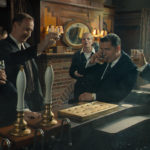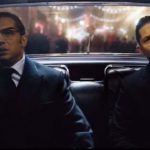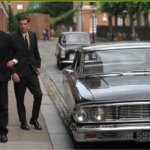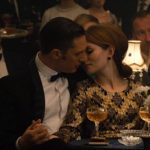I saw The Krays some years ago, the one where the Kemp boys, Gary and Martin, play the Kray twins, but this was the first time I’ve seen Legend, featuring – er – the Hardy boy. I watched it with my mother, which is something of a surprise since you would not expect a near-86 year old to be attracted to coarse and fruity language, brutal violence, but you’re never too old to learn.
In terms of accuracy of portrayals, seems little doubt that Legend is the better researched, though I have no doubt that the best film on the Krays would probably merge characteristics of both films. For example, having read around the subject a bit, contemporary accounts of George Cornell suggest to me that Steven Berkhoff‘s version is closer to the truth than that of Shane Attwooll – though we shall never truly know.
Tom Hardy has undoubtedly gone to extraordinary lengths to get the appearance, speeches, vocal inflections, mannerisms and behaviours of each brother spot on, but praise too for the cinematographic techniques that allow the two to liaise naturalistically on screen without a hint of artificiality. The use of one quality actor playing both roles definitely works better than the Kemps, who were after all musicians first and foremost.
Neither film does particularly well in terms of historical accuracy, and this Guardian article gives the newer film D+ in that respect. Suffice to say that large parts of the Kray story are glossed over or omitted entirely, and Reggie’s marriage with Frances gets scant attention (indeed 3 of the 4 marriages between the pair are not mentioned), as does much of the gangland savagery – but for one punch-up with the Richardson gang‘s hard men. I’ll come back to Frances though.
What I do like is the portrayal of the East End in the early 60s. Whether the Blind Beggar really was how it is shown in the film back in the day (in a backstreet surrounded by quiet cobbled streets) I couldn’t tell you, but now it sits on Whitechapel Road, which is a major thoroughfare. It all looks brilliant though!
The whistlestop tour of the East End à la Kray means that a number of relationships remain ambiguous. Bob Boothby flits in and out, as do Joan Collins, David Bailey, Harold Wilson, Charlie Richardson – yep, this is cameo lookalike city – even Chazz Palmintieri gets a look-in as American mobster Angelo Bruno!
What Legend does play big is the conflict between the brothers, including a another lengthy punch-up in Esmeralda’s Barn after Reggie gets out of prison. Curiously, considering the emphasis on Ronnie’s mental health issues, there is no mention of his having almost died in 1942 from a head injury suffered in a fight with Reggie, which may well have contributed to Ron’s later issues.
More screen time is devoted to the superficial charm of both men, though Ronnie is certainly imbued with greater spontaneous menace – slow-moving, slow on the uptake but highly dangerous when the unpredictable mood took him. Both twins had psychopathic traits, though Reggie hid his better with undeniable cockney charm and East End sophistication.
The trouble is, this film comes dangerously close to homage, with little recognition of the truth behind the legend. Yes, the murders of George Cornell and Jack “the hat” McVitie at the hands of the Krays twins are dealt with, but nowhere is it mentioned the many other murders carried out at their behest, including those of Ginger Marks and Frank “Mad Axeman” Mitchell among them.
Stranger still, the psychopathic gay gangster “Mad” Teddy Smith (portrayed in the film by Taron Egerton, he of Kingsman fame) is shown as a key henchman and Ronnie’s lover, yet no mention is made of the fact that Smith vanished suddenly in 1967 after a row with the brothers, and was presumed the identity of Reggie’s deathbed confession to another murder.
If you want to know the reality, I’d recommend the documentary The Krays: The Myth Behind The Legend, narrated, ironically, by Martin Kemp. This interviews known associates of the Krays, all of whom claim now they wish the boys had been shot at the height of their powers, to save everybody a lot of misery. Make no mistake, the reality was very much nastier than you can imagine.
I mentioned Frances, whom Reggie unquestionably loved. There is a lot more to her story, even allowing for the gaps and non-sequiturs in the movie. She had her own mental health issues, and her diaries mentioned drunken abuse and the use of weapons (see here), though the movie focuses more on her own drug habits.
It even mentions (but does not play) Mother’s Little Helper, and therefore reminded me strongly of Requiem For A Dream. Reggie was trying to reconcile with her at the end, there is little evidence of the psychological torment that drove her to take an overdose and die at the age of 23. But she was not, it is claimed, the timid junkie she is usually portrayed (this for example.)
The only real force of opposition to the marriage, is Mrs Shea, played with vigour by Tara Fitzgerald. Whether or not Mrs S actually turned up to the wedding dressed in funeral weeds I don’t know though it is certainly true that the family blamed Reggie for her death and tried to have Frances reinterred under her maiden name.
Consequently, the film might well use its 131 minutes to explore the legend, but it barely touches more than the renowned headlines of the gangland reality. In itself, this is typical of biopics but is more of an opportunity lost to go beyond the usual fictionalised faux-heroic accounts of violent criminals, even to the point of glamourising them by comparison with Leonard “Nipper” Read (Christopher Ecclestone.)
My overall conclusion is therefore about one and a half cheers to Legend‘s writer/director Brian Helgeland, who is, after all, American, and therefore regarding East End culture through a microscope from some far-distant universe. He was unquestionably more comfortable writing the splendid LA Confidential, which is not to say he has not minutely observed and faithfully recreated aspects of the life of the Krays twins – but not as an insider would have written them.
He could also have turned down the language, which, while authentic, is an unnecessary distraction and designed primarily to shock – which is presumably why he also wrote much effing and blinding into the superfluous and foul-mouthed remake of The Taking of Pelham 123.
Maybe the next time around, we can have a version of the Kray story written by retired gangsters? Or maybe we can just let the Krays rest happily in their graves and move on to some other and more neglected story?













